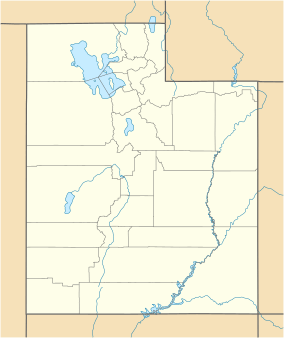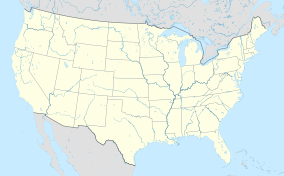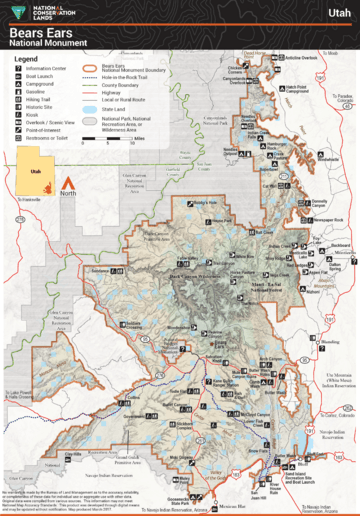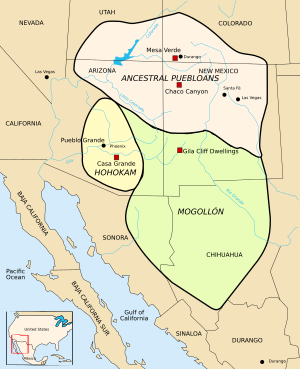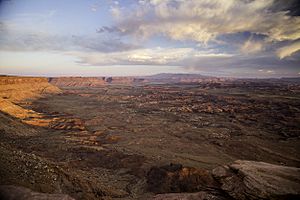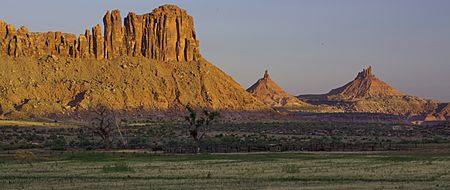Bears Ears National Monument facts for kids
Quick facts for kids Bears Ears National Monument |
|
|---|---|
| Hoon’Naqvut, Shash Jaaʼ (Navajo), Kwiyagatu Nukavachi, Ansh An Lashokdiwe | |
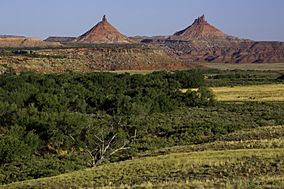
Indian Creek Canyon and the Sixshooter Peaks
|
|
| Location | Utah, United States |
| Nearest city | Blanding, Utah |
| Area | 201,876 acres (315.431 sq mi; 816.96 km2) |
| Established | December 28, 2016 |
| Governing body | Bureau of Land Management/United States Forest Service |
| Website | Bears Ears National Monument |
Bears Ears National Monument is a special protected area in southeastern Utah, United States. It was created by President Barack Obama on December 28, 2016, to protect important natural and cultural sites. The monument was originally very large, covering about 1.35 million acres. However, President Donald Trump later reduced its size by 85% on December 4, 2017.
The monument is named after the "Bears Ears," which are two tall, flat-topped hills called buttes. These buttes and the surrounding land are very important to several Native American tribes. The monument also protects the Indian Creek area, which is famous for rock climbing. The Native American names for the buttes, like Hoon’Naqvut and Shash Jáa, all mean "Bears Ears."
The land inside the monument is mostly untouched and has many historical, cultural, and natural treasures. It is managed together by the Bureau of Land Management (BLM) and the United States Forest Service. Five local Native American tribes also help manage the monument. These tribes are the Navajo Nation, Hopi, Ute Mountain Ute, Ute Indian Tribe of the Uintah and Ouray Reservation, and the Pueblo of Zuni. All of these tribes have strong historical connections to this area.
Contents
Features and Management
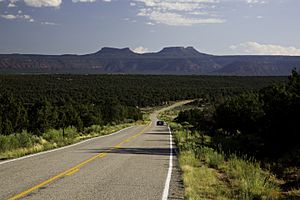
The monument gets its name from the two "Bears Ears" buttes. These buttes are very tall, rising over 8,900 and 9,000 feet high. They stand more than 2,000 feet above nearby roads. The buttes and the land around them have been considered sacred or very important by many Native American tribes for a long time.
Ancient cliff dwellings built by the Ancestral Puebloans have been found here. Some of these homes are over 3,500 years old. There are an estimated 100,000 archaeological sites protected within the monument. These sites show how people lived in this area thousands of years ago.
The monument is managed by the Bureau of Land Management (BLM) and the United States Forest Service (USFS). They work together with a group of five local Native American tribes. These tribes include the Navajo, Hopi, Ute Mountain Ute, Ute Indian Tribe, and Pueblo of Zuni. All of these tribes have family ties to this land.
Most of the land in the monument belongs to the federal government. However, some parts are owned by the State of Utah or private individuals. These privately owned lands are not part of the monument unless the federal government buys them. The monument's creation does not stop landowners from using their property.
Some important cultural sites are still within the monument's current boundaries. These include the Newspaper Rock Petroglyph Panel, which has ancient rock carvings.
History
Over 100,000 archaeological sites are protected within Bears Ears National Monument. The buttes and surrounding areas have long been considered sacred by many Native American tribes. The Bears Ears Intertribal Coalition (BEITC) described this area as ancestral land.
About 13,000 years ago, Clovis people hunted in Cedar Mesa, which is now part of the monument. Their tools, like "Clovis points," have been found there.
Later, about 2,500 years ago, the Ancestral Puebloans began living in the Bears Ears area. They left behind baskets, pottery, and weapons. These people are the ancestors of today's Hopi and Zuni tribes. They started farming about 3,500 years ago. Early cultures in this area were known for their basket-making. Over time, they built single family homes, storage buildings, and even large villages connected by roads.
Along Comb Ridge, a long rock formation, Ancestral Puebloans lived in cliff dwellings from about AD 900 to 1350. They grew corn, beans, and squash. They also built reservoirs to collect water for farming. By about 1250, the San Juan region was one of the most populated parts of North America.
Between the mid-1200s and 1285, nearly 30,000 people left the San Juan region. They moved to areas in New Mexico and Arizona. This happened because of a severe drought in the 1200s.
The Hopi people trace their family history to the Ancestral Pueblo people. The Zuni people are also descendants of these ancient cultures. They have lived in the deserts of Utah, New Mexico, Arizona, and Colorado for a very long time.
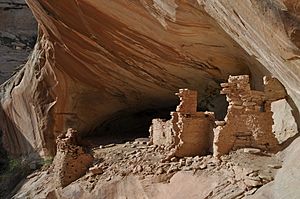
In the early 1500s, Spain claimed the ancestral lands of Native Americans in the Four Corners area. In 1848, the United States bought this land from Mexico after the Mexican-American War. In the 1860s, many Navajos were forced to leave their homes in what is known as the Long Walk of the Navajo. However, some Navajos in Utah were able to stay by hiding in canyons.
In 1906, President Theodore Roosevelt signed the Antiquities Act. This law gave presidents the power to create national monuments. These monuments protect federal land that has important historical or natural objects. The law was created to stop people from stealing artifacts from ancient sites. Bears Ears has faced problems with looting and vandalism over many years.
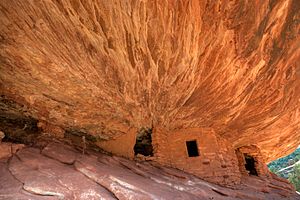
In 2009, a large investigation into the theft of archaeological artifacts happened in Blanding, a town near Bears Ears. This event helped bring attention to the need to protect the area.
Native American tribes in the area began discussing how to manage the public lands of Bears Ears. In 2010, the Utah Diné Bikéyah (UDB), an organization representing Utah Navajos, started working on a plan for land use.
In 2015, representatives from the Hopi, Navajo, Ute Mountain Ute, Pueblo of Zuni, and Ute Indian Tribe formed the Bears Ears Inter-Tribal Coalition (BEITC). This group proposed to President Barack Obama that 1.9 million acres be designated as a national monument. They wanted to protect areas like Cedar Mesa, Indian Creek, and Comb Ridge.
Designation under President Obama
On December 28, 2016, President Obama used the Antiquities Act to declare Bears Ears National Monument. It covered about 1.35 million acres. Some areas that the tribes had proposed were not included in the final monument boundaries.
Reactions
The creation of the monument caused different reactions in Utah. The Bears Ears Inter-Tribal Coalition and environmental groups praised the decision. They had worked hard to protect the land. Navajo Nation President Russell Begaye said the decision would protect the land for future generations.
However, some local residents and Republican leaders in Utah were disappointed. They felt that the monument designation was a "land grab" and would limit access to the land. Utah Governor Gary Herbert and Congressman Jason Chaffetz expressed their strong disapproval.
Monument Reduced in Size by President Trump
In February 2017, Utah's governor and state legislature asked President Donald Trump to cancel the monument designation. It was unclear if a president had the legal power to completely remove a monument created under the Antiquities Act.
Because of Utah's opposition to Bears Ears, some outdoor companies decided to move their business out of the state. For example, Patagonia, an outdoor clothing company, and the Outdoor Retailer Market, a large trade show, moved their events from Utah to other states.
Federal Review and Reduction
In April 2017, the Trump administration ordered a review of many national monuments, including Bears Ears. On December 4, 2017, President Donald Trump announced an 85% reduction in the size of Bears Ears National Monument. The monument was redrawn into two separate areas: Indian Creek and Shash Jáa. The Shash Jáa unit includes the Bears Ears buttes.
This reduction was seen as a win for some energy companies interested in mining for fossil fuels and uranium in the area. Many uranium mining claims were located outside the new, smaller monument boundaries.
Legal Challenges to the Reduction
Soon after the reduction, three separate lawsuits were filed in federal court. These lawsuits challenged President Trump's decision to shrink Bears Ears National Monument. The groups that sued included five Native American tribes, conservation organizations, and the outdoor company Patagonia. They argued that the president did not have the legal power to reduce the monument's size.
These lawsuits were combined into one case. The case was still ongoing at the time of the 2020 presidential election. Historically, a few national monuments have been reduced in size by previous presidents, but not since 1963.
Images for kids
-
Valley of the Gods, an area outside the redefined monument boundaries of December 2017


